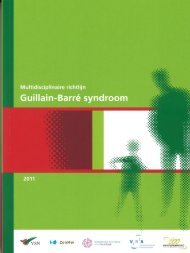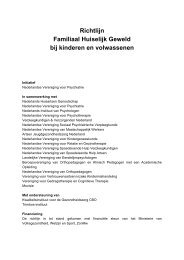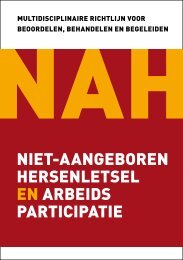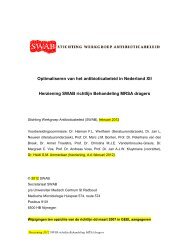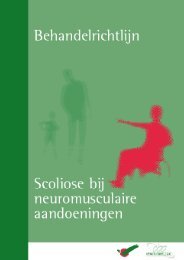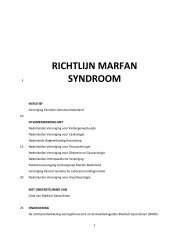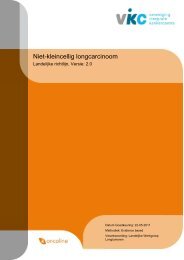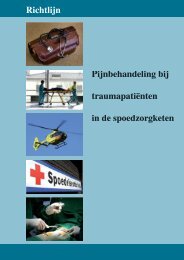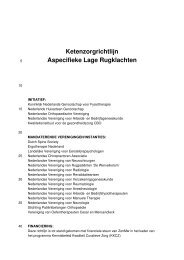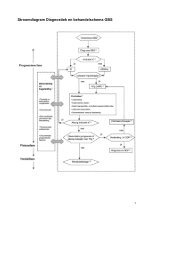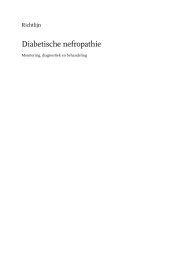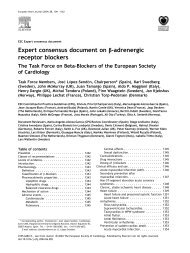Richtlijn: Otitis Externa - Kwaliteitskoepel
Richtlijn: Otitis Externa - Kwaliteitskoepel
Richtlijn: Otitis Externa - Kwaliteitskoepel
Create successful ePaper yourself
Turn your PDF publications into a flip-book with our unique Google optimized e-Paper software.
Keuze oordruppels<br />
Uitgangsvraag 4<br />
Welk preparaat moet gekozen voor de initiële topische behandeling?<br />
Onderbouwing<br />
A variety of topical preparations are approved in the Netherlands for treating AOE. Also there are<br />
some preparations (mostly ophtalmological approved treatments) on the market which could be<br />
effective in the treatment of AOE (Attachment 2). Most of those currently available in the<br />
Netherlands provide antimicrobial activity or reduction of imflammation through:<br />
1) an antibiotic, such as an aminoglycoside, polymyxin B, a quinolone<br />
2) a steroid, such as hydrocortisone or dexamethasone<br />
3) a low pH antiseptic, such as aluminum acetate solution or acetic acid.<br />
Two methodologically strong systematic reviews were conducted recently; Kaushik 2010 (Cochrane)<br />
and Rosenfeld 2006 (American Association of Otolaryngology – Head and Neck Surgery Foundation<br />
(AAO-HNSF)). We used both to validate the conclusions of this guideline.<br />
Differences of meta analyses<br />
The Cochrane review detected three additional studies conducted prior to 2005. Furthermore, since<br />
the Cochrane review is of later date than the AAO-HNSF, they included six more recent studies.<br />
Following from differences in methodology, the Cochrane study excluded 11 studies compared to the<br />
AAO-HNSF practice guideline. There are subtle but important differences in the way in which the<br />
results were analysed. The “antiseptic versus antibiotic” comparison category in the AAO-HNSF<br />
review included treatments containing steroids. The Cochrane review chose to analyse trials<br />
containing steroid components separately as the steroid component will have had its own<br />
therapeutic effect and is likely to have confounded the result. This same applies to their “quinolone<br />
versus non-quinolone” comparison, which also included treatments containing steroids. These<br />
differences resulted in the AAO-HNSF review having 13 meta analyses compared to only three in the<br />
Cochrane review.<br />
Conclusions meta analyses<br />
Despite these differences the conclusions were similar. The Cochrane review conclusions are<br />
presented in the next section.<br />
High quality level 1 evidence regarding interventions for acute otitis externa is sparse. The<br />
comparison categories studied in the Cochrane review mostly contain single trials. Only three metaanalyses<br />
were possible. Results are largely based on odds ratios calculated from single trials, most of<br />
which have very broad 95% confidence intervals because of small to modest sample sizes. A number<br />
of significant results have 95% confidence intervals whose limits approach 1.0, suggesting that<br />
negligible differences cannot be excluded. A number of recent trials report results using P values that<br />
do not allow the magnitude or precision of the results to be evaluated, and as a result any findings<br />
merit cautious interpretation. Having said all this, a few salient points can be made from the<br />
evidence available: topical treatments alone are effective for uncomplicated acute otitis externa.<br />
25 <strong>Richtlijn</strong> <strong>Otitis</strong> <strong>Externa</strong> 2010<br />
Nederlandse Vereniging voor Keel-Neus-Oorheelkunde en Heelkunde van het Hoofd-Halsgebied




